GARDEN
8 Houseplants to Beat The Winter Blues
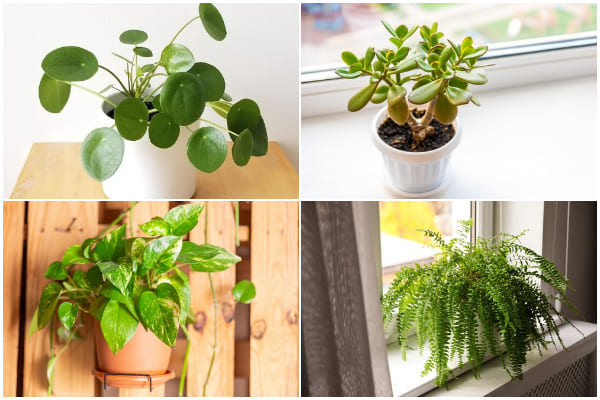
A long winter with frigid, and dark, sometimes cause you some winter blues. Consider growing some of 8 Houseplants to Beat The Winter Blues and freshen up your house. With many benefits for the mind and body, these houseplants are a great way to get through the boring days of winter. Just their presence in the house can turn up your happiness level.
1. Chinese Money Plant
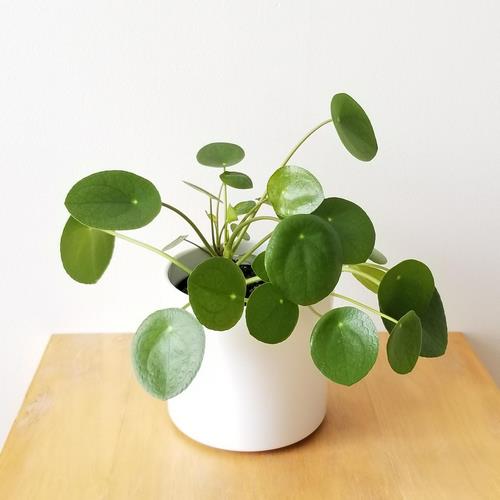
Native to China’s Yunnan province, the Chinese money plant display beauty’s leathery leaves to brighten up your home. It also is a lucky plant that symbolizes the promise of wealth and abundance, according to Feng Shui. This is why the houseplant brings hope to the dreary season. Place the pot in a southeast corner to attract financial prosperity and abundance as you desire.
It prefers to grow in bright and indirect light with ưell-draining, peaty potting soil. It just needs little water once a week. Also, it is non-toxic to your pets.
2. Jade Plant
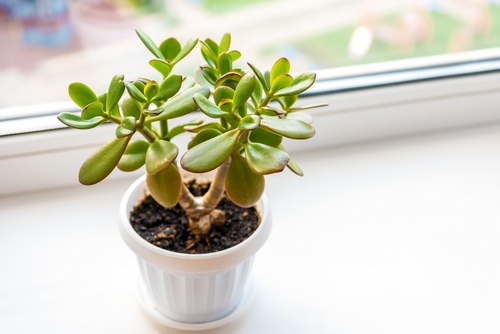
Jade Plant is one of the best air-purifying plants making it become increasingly important to help in ventilating the atmospheric staleness so typical of winter. Also, in Feng shui, it brings good luck, growth, and renewal.
This plant loves growing in a spot where it gets direct sun with sandy and well-draining. It belongs to the succulent family, so it doesn’t need water much. Just give water when the top of the soil becomes dry. Be aware, it contains toxic, keep your kids and pets stay away from it.
3. Devil’s Ivy
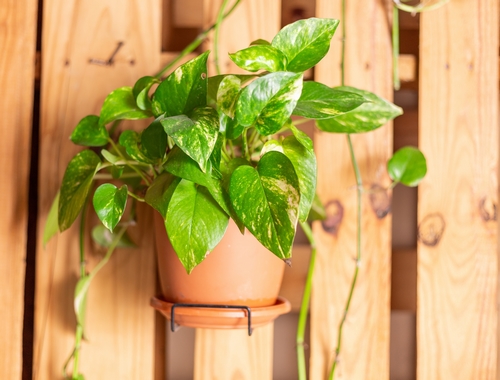
Devil’s Ivy is called Golden Pothos. It is an easy-to-grow houseplant that can survive in any condition, even in dark and neglectful conditions. By producing large and variegated green leaves, this plant is great for adding life to your home when the weather outside is grey and bleak.
It grows best in bright, indirect light with rich and well-draining soil. It also is a low-maintain plant, so you just give it water once every week or two when the soil feels dry. You also grow it in a hanging basket for a stunning look as well as protect your kids and pets because it is a toxic plant.
4. Air Plant
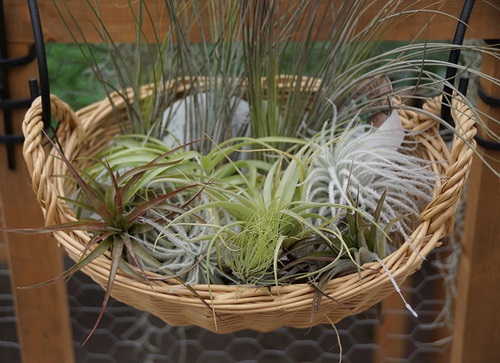
The Air Plant has lots of species, approximately 500 species. All are famous for their long, springy leaves and don’t need to grow on the soil making them especially good for winter. Other plants usually become finicky on winter days, these plants just need the same care all year round. Simply you just soak them in water every one to two weeks or mist them per day, then display them in a terrarium or hang them on the wall to watch their beauty through the changing of the seasons.
It needs bright to moderate indirect light for happy growth. It is non-toxic to cats and dogs.
5. Aloe Vera
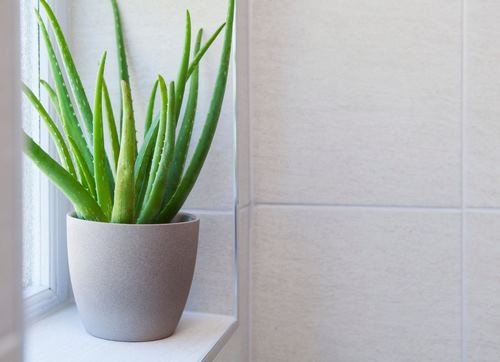
Aloe Vera acts as a natural moisturizer so it is commonly incorporated into skincare products, making it especially handy in the dry winter months. The plant loves to sunbathe but if gets too much direct sun, the leaves turn brown.
It requires bright, indirect light for optimum growth but doesn’t need water regularly, once every two to three weeks. Sandy cactus potting soil is ideal for its growth. It is unsafe for cats and dogs because of its toxicity.
6. Spider Plant
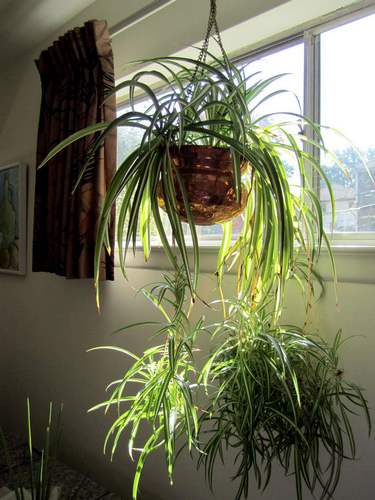
Spider Plant originates from tropical and southern Africa, the Spider Plant will help you remind warm, sunny days in the winter season. The plant features a rosette of thin, leggy, green-and-yellow foliage. It looks great when grown in hanging baskets because of its long stems spilled down the pots.
It grows easily as long as gets well-draining potting soil. It prefers to grow in indirect sunlight but also tolerates low-light conditions and drought. On cold winter days, once-a-week or even less frequent waterings are sufficient. It is safe for pets!
7. Fern
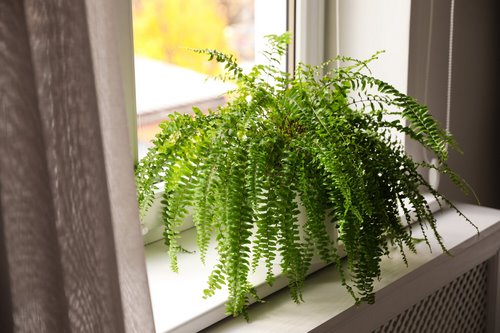
Ferns can’t even survive outside in the winter, but they thrive on high humidity indoors, especially in a bathroom where it gets hot, steamy showers. When grown in the right condition, they will give off rainforest vibes, even when it’s snowing
For the best growth, give them well-draining soil with plenty of organic matter. Place the pots in direct sun and water once or twice a week but keep the soil moist. They are safe for cats and dogs because they don’t contain toxic.
8. Parlor Palm
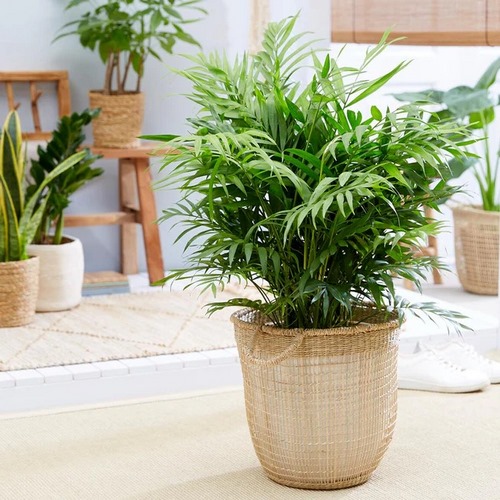
Parlor Palm is a tropical plant, it grows well in drought and poor light conditions indoors, so it is an excellent option to have a space in your home on winter days. The plant can reach 6 feet tall to give your living space a fresh green volume.
Grow it in three-gallon pots with peaty potting soil and place it in bright, indirect light for happy growth. Also, water once every week or two when the soil starts drying. It is non-toxic to dogs and cats.
GARDEN
15 Houseplants That Grow Well in Vases with Water
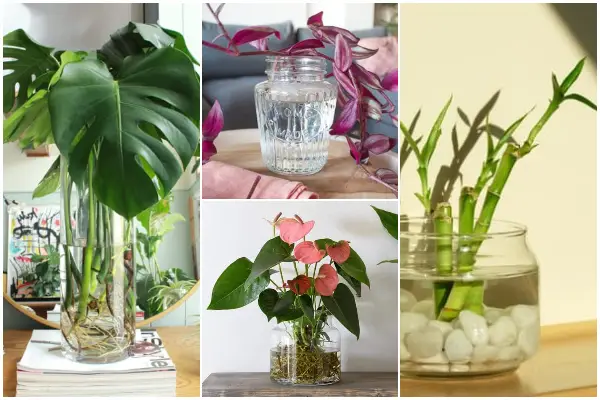
Vases are a fun way to display the beauty of flowers or propagate plants from cuttings. No need for the soil, simply immerse the nodes or the end of the stems in the water, add some decorative gravel, and you are done! They are so easy to make that everyone can create them at home, and especially your hand is always clean.
Instead of decorating flowers, check out the 15 Houseplants That Grow Well in Vases to make the living space more impressive in your own way.
1. Pothos
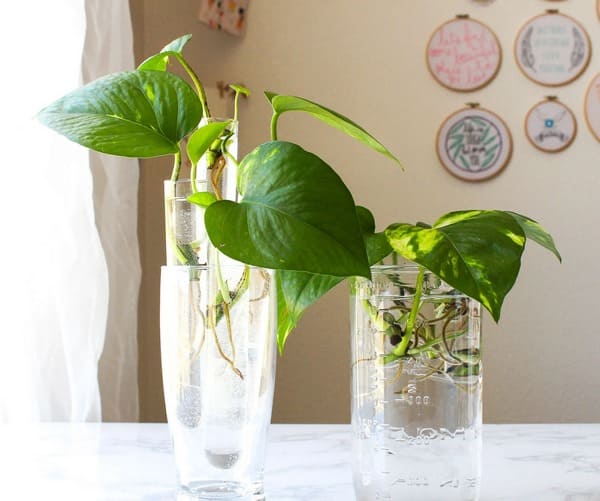 Image source: instructables
Image source: instructables
This Pothos displays heart-shaped green and white leaves making it looks stunning in decorative vases. The houseplant needs a little care and indirect light for happy growth.
2. Spider Plant
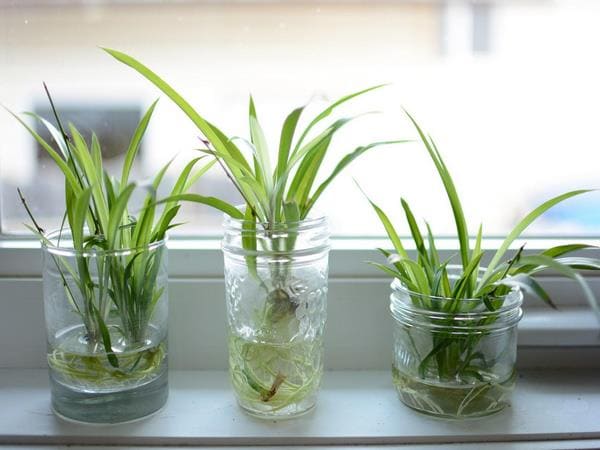 Image source: gardenmanage
Image source: gardenmanage
Spider Plant is one of the most popular houseplants. You can grow in pots in soil or in vases in water. Simply, cut off one of the plantlets, then put it in your vase.
3. Snake Plant
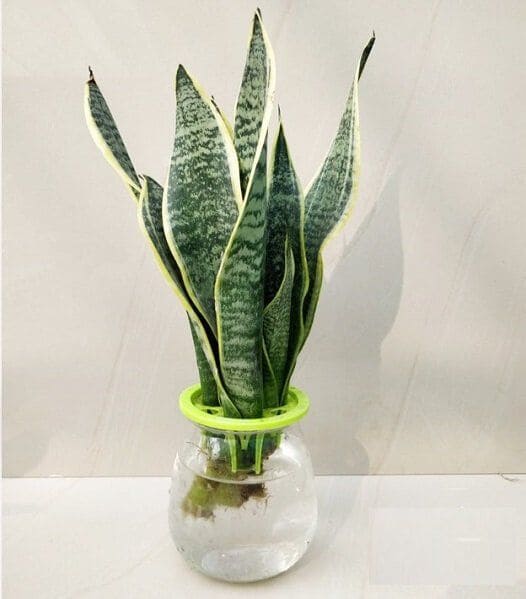 Image source: plantdecors
Image source: plantdecors
Snake Plant looks great in a transparent vase with tall variegated leaves. It is also excellent for purifying harmful toxins from the air.
4. Monstera
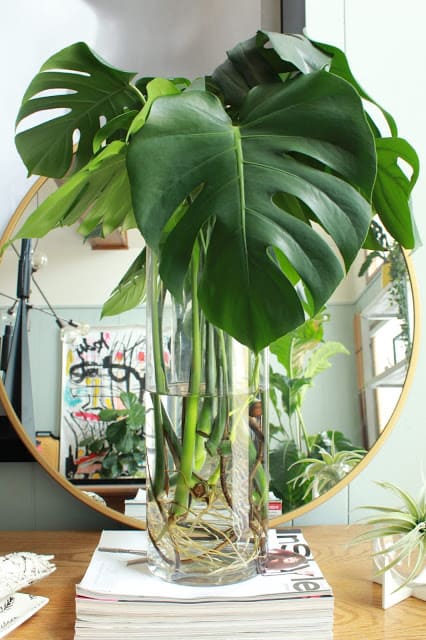 Image source: keephouseplantsalive
Image source: keephouseplantsalive
Monstera offers unique cut leaves looking gorgeous when put in a matching vase. This low-maintenance plant also grows well in the water environment.
5. Purple Heart Plant
 Image source: creativejewishmom
Image source: creativejewishmom
By providing deep purple leaves with delicate and tiny pink flowers, this Purple Heart Plant looks more beautiful in a vase.
6. Watermelon Peperomia
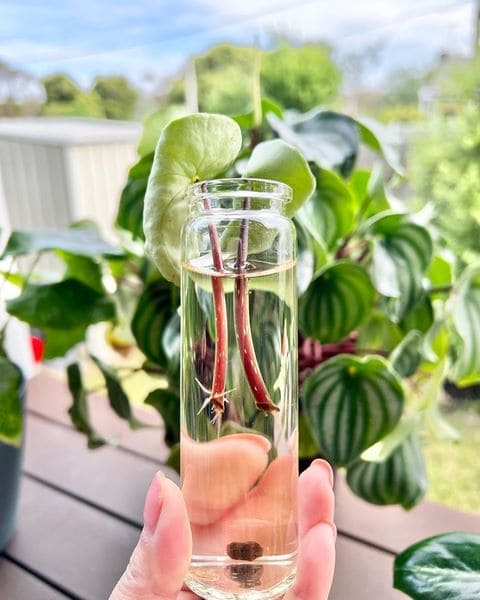 Image source: kirkdamaso
Image source: kirkdamaso
This Watermelon Peperomia shows off thick and bushy foliage, making it an amazing centerpiece. The best varieties are Columbian and Watermelon Peperomia which you should choose to grow.
7. Geranium
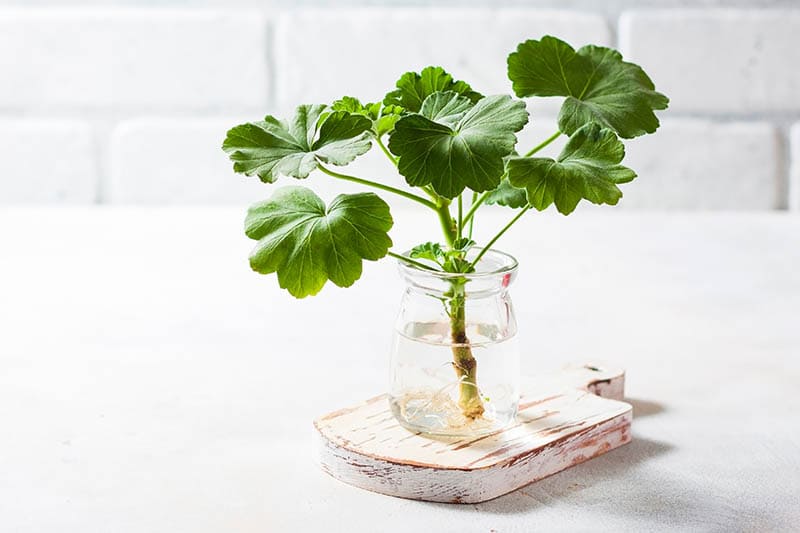 Image source: gardenerspath
Image source: gardenerspath
Geranium is a well-loved houseplant because of its easy-to-take-care properties along with its bright pink flowers. Growing it in a vase with water is a great way to start a plant from cuttings!
8. Alocasia
 Image source: carousell
Image source: carousell
Alocasia bears arrow-shaped leaves that look stunning in glass vases. It is quite easy to propagate and grows happily in indirect light.
9. Chinese Money Plant
 Image source: bonjourtangerine
Image source: bonjourtangerine
Chinese Money Plant is a compact specimen that looks impressive when kept on small tables and windowsills.
10. Wandering Jew
 Image source: lady-bella
Image source: lady-bella
This fast-growing plant brings pretty purple-colored and variegated leaves looking smashing in vases.
11. English Ivy
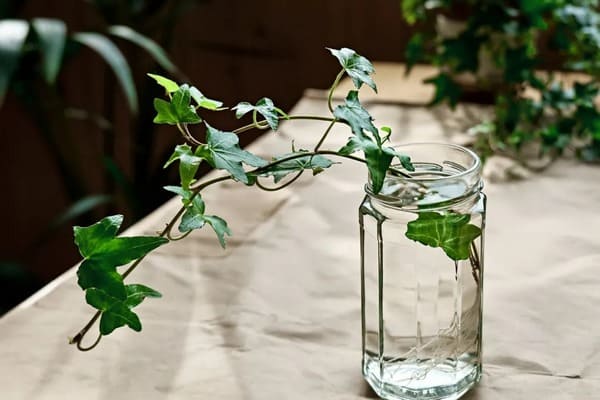 Image source: ruralsprout
Image source: ruralsprout
English Ivy is an evergreen vine with flexible stems dangling down, which makes it look quite charming in a vase.
12. Swiss Cheese Plant
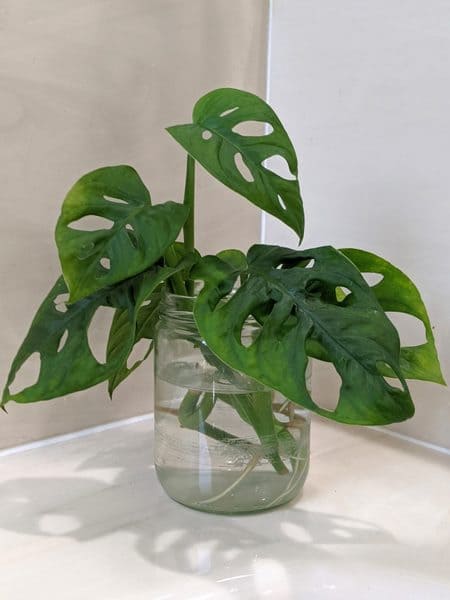 Image source: pottedpixie
Image source: pottedpixie
The leaves of this Plant have natural holes looking like swiss cheese, as the name suggests. This plant also loves climbing so you can place it near a shelf and watch it grow upwards!
13. Peace Lily
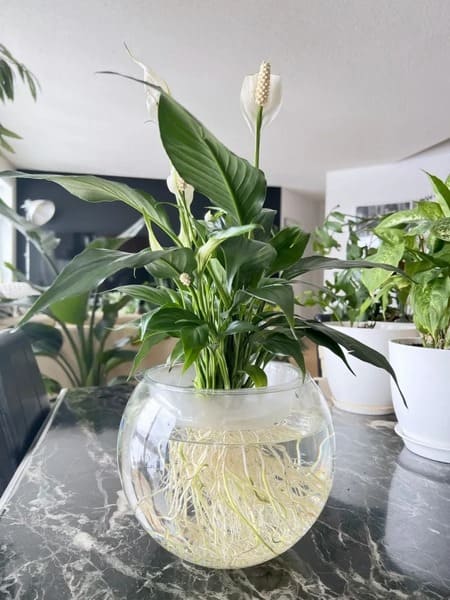 Image source: jaydeemahs
Image source: jaydeemahs
Peace Lily is a popular houseplant that showcases the combination of the white and green leaves looking quite classy. It is also easy to maintain.
14. Anthurium
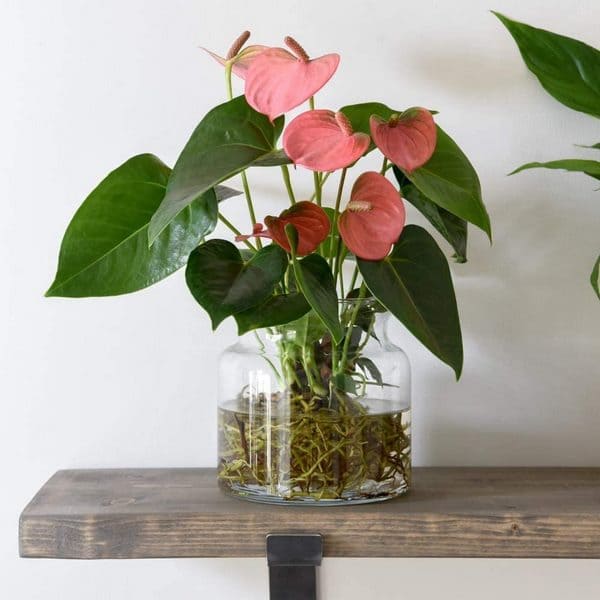 Image source: amazon
Image source: amazon
Anthurium blooms colorful bracts pop against dark green foliage making. It can do well in a transparent vase in the water.
15. Lucky Bamboo
 Image source: modernfarmer
Image source: modernfarmer
Lucky Bamboo is an easy-to-maintain plant that can grow well in any condition. It also is famous for its air-purifying ability you can grow.
GARDEN
15 Different Fern Types to Grow Indoors
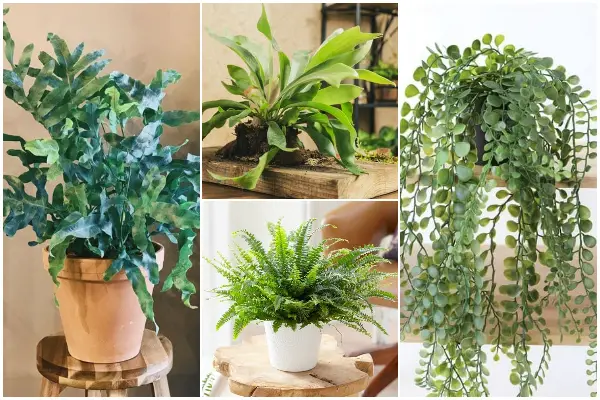
Want to bring tropical beauty to the home, indoor ferns are a lush and rewarding addition to any space. With vibrant, cascading fronds that stand out among other indoor plants, they are the top options for adding plant life and texture to your living space.
Here are the 15 Different Fern Types below that you will love growing. Like other houseplants, they also adapt to indoor conditions with minimal care.
#1 Kangaroo Fern (Microsorum diversifolium)
 Image source: rhsplants
Image source: rhsplants
Kangaroo Fern comes from Western Australia that features odd-shaped, long bright green fronds growing from creeping fuzzy rhizomes. To grow this fern, let’s give it moist soil and place it in a warm location.
#2 Boston Fern (Nephrolepis exaltata)
 Image source: etsy
Image source: etsy
Boston Fern is also called the sword or ladder fern, it has blue-green sword-shaped fronds that stay evergreen with arching gorgeous erect leaflets. This plant grows well in low light and just with minimalistic attention.
#3 Botton Candy Boston Fern (Nephrolepis ‘Cotton Candy’)
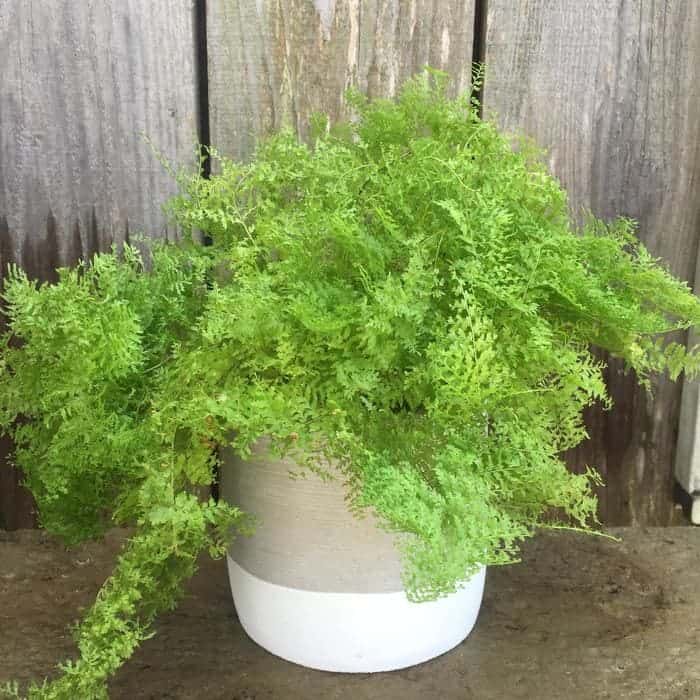 Image source: gatewaygardens
Image source: gatewaygardens
Cotton Candy Boston Fern does well both indoors and outdoors to show off fuzzy, soft, and bright green fronds. It looks great when grown in pots or hanging baskets. For its happy growth, give it in a shady location outdoors and on an Eastern direction window indoors.
#4 Bird’s Nest Fern (Asplenium nidus)
 Image source: springhillnursery
Image source: springhillnursery
Bird’s Nest Fern is an easy-care epiphyte variety as long as it gets enough humidity. In the right condition, it will bring leathery, strap-shaped, shiny, bright apple green fronds patterned in dark brown to black midribs and wavy edges.
#5 Blue Star Fern (Phlebodium aureum)
 Image source: instagram
Image source: instagram
Blue Star Fern is an epiphyte fern that adapts fast to the indoor environment. Its blue-green leaves are sometimes speckled with a silver or gray hue. To plant it indoors, give it well-draining soil, or an equal mix of perlite, pumice, or gravel.
#6 Lemon Button Fern (Nephrolepis cordifolia ‘Lemon Button’)
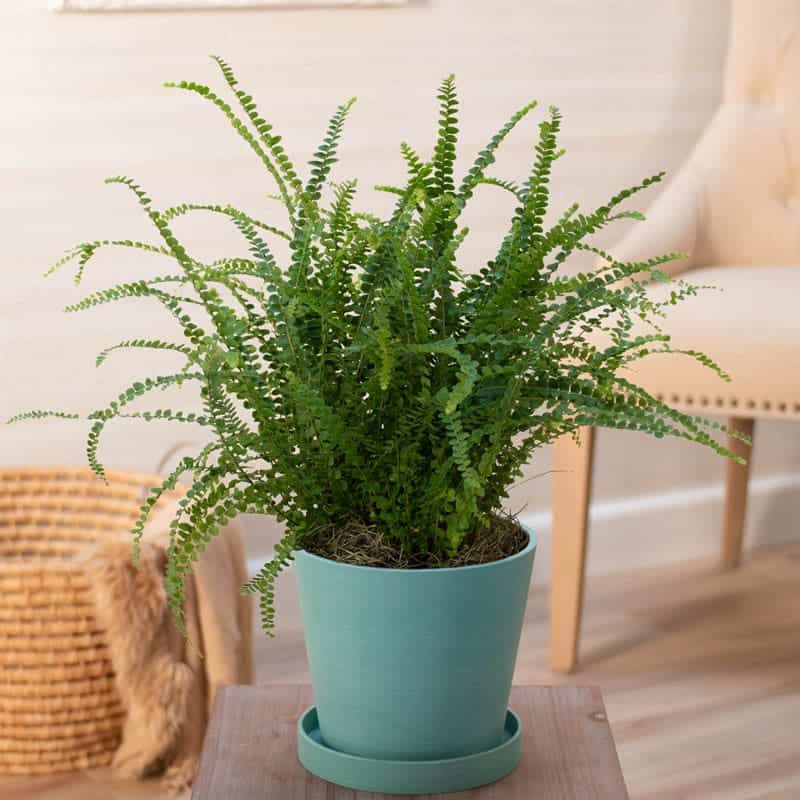 Image source: brecks
Image source: brecks
Lemon Button Fern showcases tiny, golden-green round button-like leaflets. When grown in hanging baskets or in terrariums, its long, arching leaves give a stunning look. For its optimum growth, give it medium to bright light and high humidity.
#7 Squirrel’s Foot Fern (Davallia bullata)
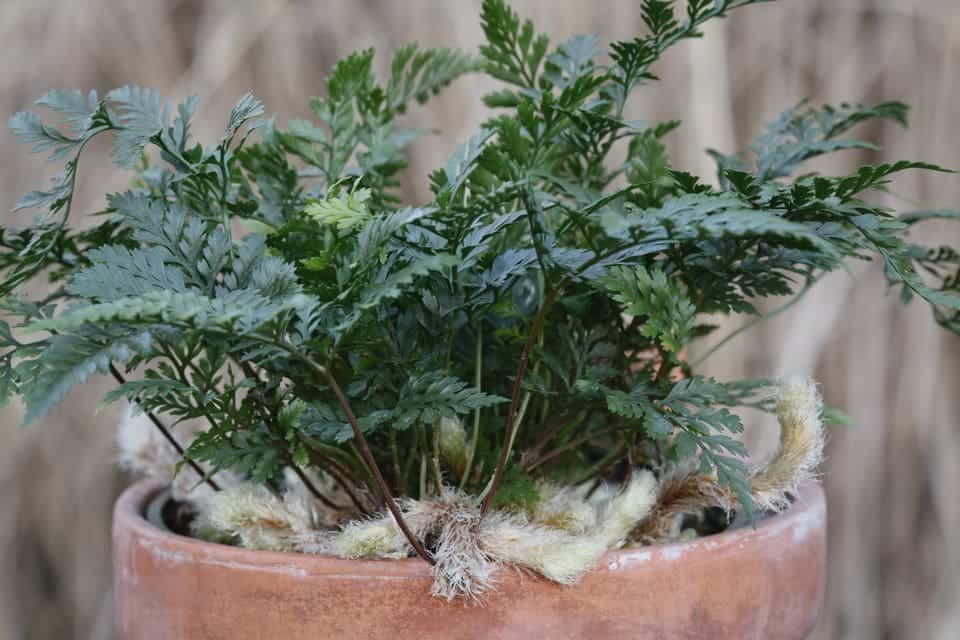 Image source: greencloudsolutions
Image source: greencloudsolutions
In the wild, the plant’s rhizomes of the Squirrel’s Foot Fern wrap around a tree to cling to them, hence the name. Place in indirect light and highly humid conditions, it will grow best to produce lacy and green foliage.
#8 Cretan Brake Fern (Pteris cretica)
 Image source: etsy
Image source: etsy
Native to Europe, Africa, and Asia, this evergreen fern has innate, flat green fronds with attractive variegation and wavy edges. The Cretan Brake Fern favors growing in a humid environment, so you can grow it in hanging baskets and place it in bathrooms or on tabletops.
#9 Maidenhair Fern (Adiantum)
 Image source: englishgardens
Image source: englishgardens
Maidenhair Fern is a popular fern that performs delicate, light, lacy, airy, bright green leaves on slender black stems, making it look great in hanging baskets. This fern variety requires slight moisture and bright indirect sunlight for its happy growth.
#10 Asparagus Fern (Asparagus aethiopicus)
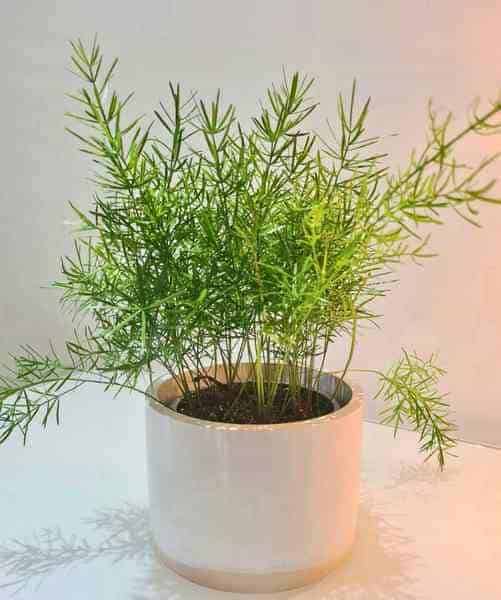 Image source: jensplantsandflorist
Image source: jensplantsandflorist
Asparagus Fern is one of the best hanging ferns that you can in baskets and macrame holders to enjoy its lacy-green foliage leaves. To grow this fern, give it humid locations and mist regularly, especially in summer.
#11 Japanese Holly Fern (Cyrtomium falcatum)
 Image source: plantify
Image source: plantify
Japanese Holly Fern shows off serrated, sharp-tipped long deep green leathery fronds that look like holly branches. This fern grows well both in partial sun and shade, so it thrives well indoors with minimum maintenance.
Native to New Zealand, the Button Fern is a beautiful, easy-to-grow fern. It displays round and small leaflets or ‘buttons’ on slim stems, hence the name. This fern variety adapts well to average indoor conditions.
#12 Rabbit’s Foot Fern (Humata tyermanii)
 Image source: hearthandvine
Image source: hearthandvine
Rabbit’s Foot Fern loves growing in bright, indirect light. It produces dark green, delicate, fine-textured fronds on fuzzy root-like stems (rhizomes).
#13 Staghorn Fern (Platycerium)
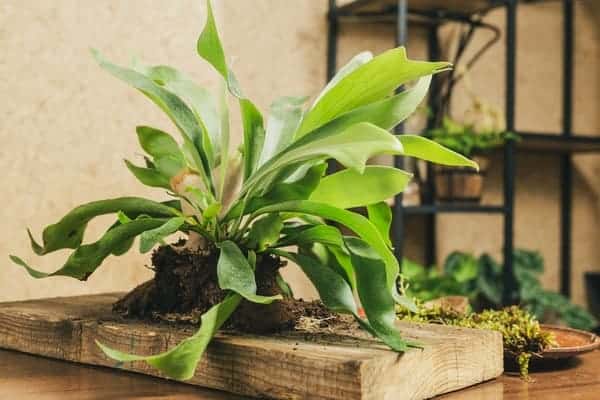 Image source: justhouseplants
Image source: justhouseplants
Staghorn Fern is a stunning epiphytic fern that offers exotic green fronds resembling the horns of an elk or male deer. It is easy to grow from propagating its side shoots or spores. It grows well in bright, indirect light, well-watered in a warm, and well-draining starter mix.
#14 Button Fern (Pellaea rotundifolia)
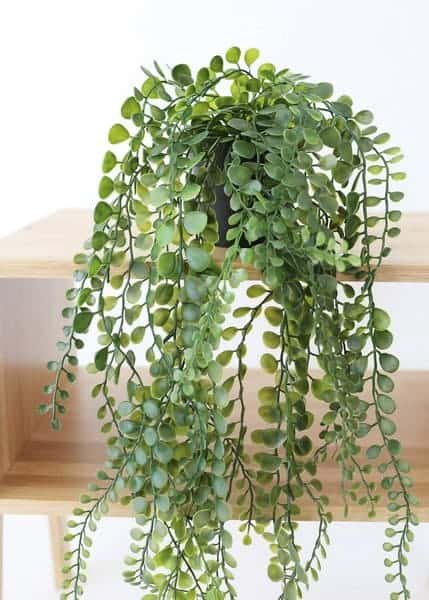 Image source: ifloralart
Image source: ifloralart
Native to New Zealand, the Button Fern is a beautiful and easy-to-grow plant. It produces round and small leaflets or ‘buttons’ on slim stems, hence the name.
#15 Christmas Fern (Polystichum acrostichoides)
 Image source: bigplantnursery
Image source: bigplantnursery
The fern variety offers glossy and green fronds that give the best color around Christmas time, so its name comes from this. Grow it in bright and indirect light for the best color. Also, water the plant once a week and keep the soil consistently moist.
GARDEN
15 Best Houseplants for Your Bathroom
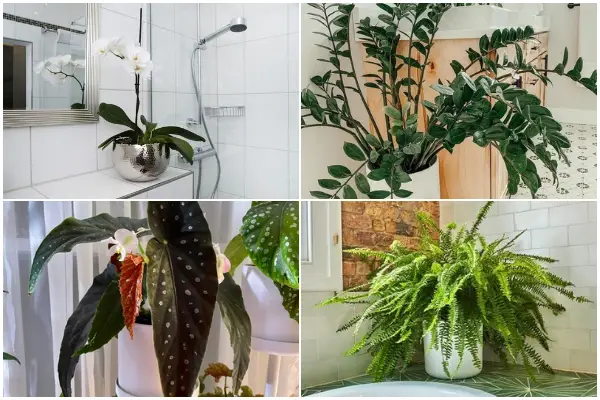
The bathroom is always the most cleaned in the house but it is missed in decoration. Most people also think that the area of the bathroom is small that can’t set any kind of decoration or apply sophisticated architecture. However, adding a green touch by growing some of the best bathroom plants below will give your bathroom a fresh look!
1. Cast Iron Plant
 Image source: plantvine
Image source: plantvine
This incredibly tough houseplant, which appears to thrive on neglect, certainly lives up to its name. The cast iron plant can survive low light, infrequent watering, and extreme heat.
Nevertheless, for best results place this potted plant in low to moderate light – keeping out of direct sunlight, and water it regularly, allowing it to dry out before re-watering.
The cast iron will happily thrive in temperatures from 50 to 85 degrees.
2. Dracaena
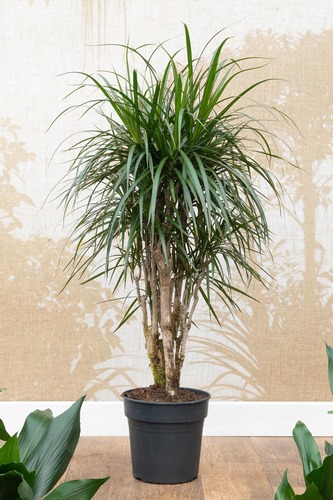 Image source: houseofplants
Image source: houseofplants
Dracaena plants, or dragon plants, are fantastic air purifiers which come in over 40 varieties.
This undemanding plant prefers light shade as its leaves will scorch if too bright; and a level of humidity not generally found in most rooms. Therefore, by placing your dragon plant in the bathroom, the lighting and humidity will prevent brown leaf tip and keep its greenery bright and flawless.
3. Orchid
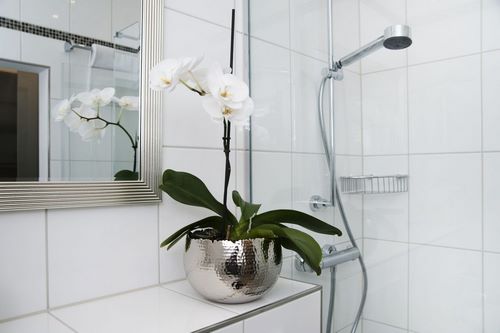 Image source: realsimple
Image source: realsimple
Give your bathroom a luxury spa feel with the addition of a subtle yet elegant orchid plant.
Place your orchid on the bathroom windowsill, where the indirect sunlight will provide adequate light but won’t cause leaf scorch; while the high humidity mirrors the flower’s natural environment.
It’s also a relatively compact flower making it perfect for smaller rooms, where it can be perched on the corner of the bathtub or next to the sink.
4. Pothos
 Image source: bobvila
Image source: bobvila
The golden pothos boasts beautiful marbled, heart-shaped leaves and is yet another low maintenance plant for your bathroom.
Ideal greenhouse conditions for this plant are very bright indirect light, high humidity, and warm temperatures.
However, as the bathroom ticks two out of three of these conditions, your pothos should do just fine indoors, although its leaves many not grow to the gigantic size they would with more light!
In order to stop the pothos getting out of control, and to save on space, hang it from the ceiling or high shelf.
5. Aloe Vera
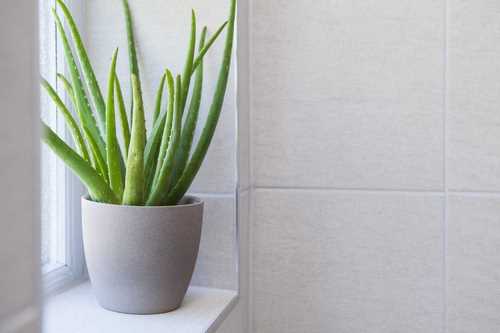 Image source: gardentabs
Image source: gardentabs
The aloe plant just keeps on giving! Not only is it known as the ‘plant of immortality’ because it is so difficult to kill, it is an incredibly useful plant to have around the home.
Aloe vera juice is bursting with vitamins and minerals, while the gel can be used as a topical treatment for minor cuts and burns, insect bites, dry skin and more.
This striking and healing plant should be placed close to the bathroom window and, because of its low water requirements, the humidity alone may meet most of its water needs!
6. Peace Lily
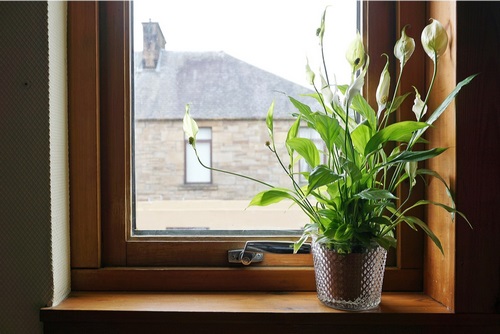 Image source: bustlingnest
Image source: bustlingnest
The peace lily is a striking flower, with glossy leaves and white blooms. It thrives in low light conditions, although it should be exposed to some indirect sunlight.
To simulate the natural humidity of the tropics, a daily misting or position next to a steamy shower is a must for the peace lily.
It’s another of NASA’s best plants for air purity, as it helps to filter out harmful benzene, trichloroethylene, and formaldehyde toxins.
7. Chinese Evergreen
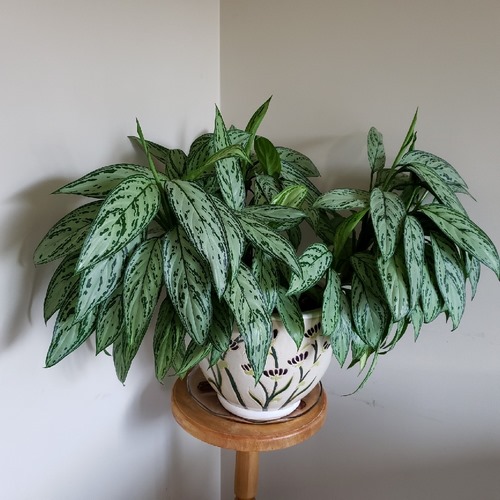 Image source: gardentags
Image source: gardentags
Boasting green leaves streaked with white or yellow, the tropical Chinese evergreen is one of the most durable plants you can grow, and has even been described as ‘almost foolproof’!
These plants thrive in medium to low light, or indirect sunlight. Although the Chinese evergreen prefers the warm temperatures and humid conditions of the bathroom, it’s flexible enough to tolerate other environments if necessary.
8. Philodendron
 Image source: sunrisespecialty
Image source: sunrisespecialty
This tropical indoor plant requires little in the way of care.
Philodendrons prefer the medium light intensity they would have on the jungle floor. If the light is too intense, its leaves will turn yellow; but if the leaves are widely spaced, it may need more light so you should consider installing fluorescent bulbs.
Although this hardy plant can tolerate average humidity, high levels promote lush, shiny foliage. Ideal growing temperatures are between 75 and 85 degrees F.
9. Bamboo
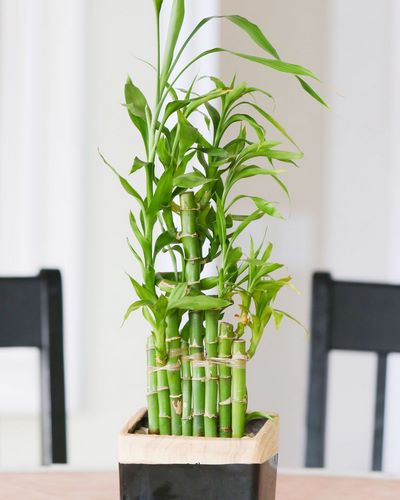 Image source: housebeautiful
Image source: housebeautiful
Lucky bamboo needs very little light to grow, and should be placed in low, indirect light.
It doesn’t even need any soil – simply pop the stalk into a container filled with pebbles and water. Change the water every two to four weeks.
Be warned that this is a fast growing plant, but you can curtail its growth by providing a physical barrier (such as a recessed shelf) or by shaping it regularly.
10. Snake Plant
 Image source: instagram
Image source: instagram
Also known as Mother-in-Law’s Tongue, the leaves of the snake plant grow upright, and feature yellow or white edging.
One of the hardiest houseplants, the snake plant can survive low light levels and is flexible in terms of heat and water.
The snake plant also filters some nasty household toxins from the bathroom air – including formaldehyde which can be found in cleaning products, tile grout, adhesives, and even some cosmetics!
11. ZZ Plant
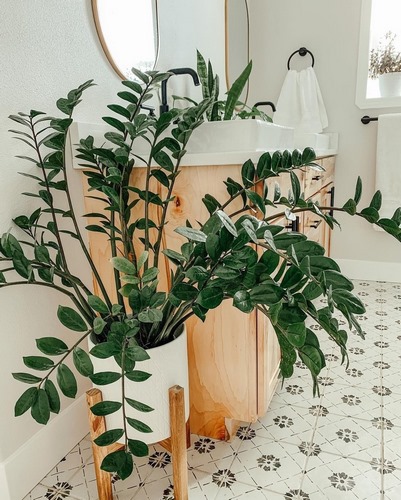 Image source: stylecurator
Image source: stylecurator
Dubbed the ‘eternity plant’ because it can tolerate quite a bit of neglect, the ZZ boasts beautiful oval-shaped, glossy leaves that will bring a fresh and vibrant feeling to any bathroom.
Although deep shade or direct sunlight don’t work for this plant, it can grow in most other light conditions such as a north, east or west facing window; and in a wide humidity range.
12. Spider Plant
 Image source: homedit
Image source: homedit
Commonly found in public spaces, the spider plant helps remove odors, fumes and around 90% of formaldehyde from the air.
This plant can grow in a wide range of conditions and requires little in the way of care. Because of this, they work well in bathrooms where they get either full sun or shade, although if plantlets fail to develop the plant is probably not getting enough light.
Allow the top layer of the soil to dry out between waterings.
13. Begonia
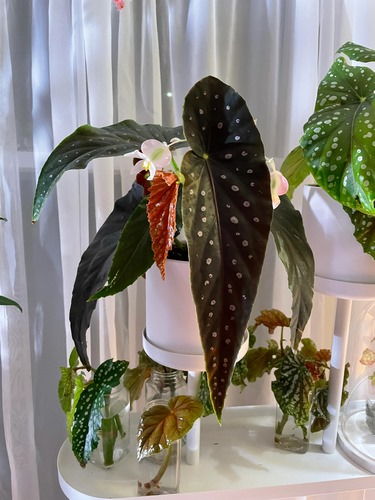 Image source: reddit
Image source: reddit
These pretty blooms do well indoors.
In fact, in many climates, they must be overwintered inside – with the bathroom being one of the best locations to do just this.
Begonias do best in fluorescent lighting, although they can survive when placed in window locations too (the exception being north-facing windows). They also require daily bathroom humidity or regular misting.
14. Ivy
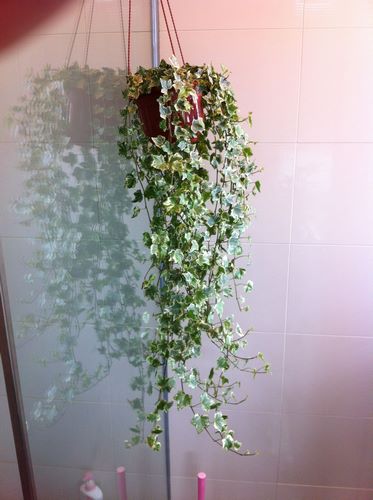 Image source: pinterest
Image source: pinterest
Ivy, particularly English Ivy, is one of NASA’s top air purifying plants. It can even help you keep the bathroom clean and hygienic by removing feces and mold from the surrounding air!
In bathrooms where space is at a premium, the ivy plant can be placed on a ledge or in a hanging basket where the leaves can elegantly trail down.
Needing just moderate exposure to sunlight, this evergreen vine enjoys the high humidity levels commonly found in bathrooms.
15. Boston Fern
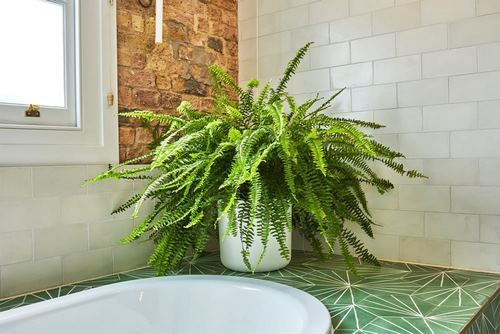 Image source: patchplants
Image source: patchplants
A popular variety of fern with frilly leaves and long, hanging fronds, the Boston fern is native to sub-tropical and tropical rain forests.
It grows best when placed on a windowsill or in a position which receives lots of indirect light. Humidity and temperatures of between 55 and 75 degrees are also important for your fern to thrive. In the growing months, the soil should be kept moist, but not saturated.
Other ferns also do well in bathrooms, including the Asparagus, Staghorn, and Bird’s Nest varieties.
-
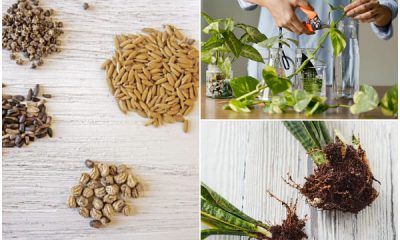
 GARDEN10 tháng ago
GARDEN10 tháng ago4 Easiest Ways to Get Free Plants
-

 ANIMALS10 tháng ago
ANIMALS10 tháng agoBritish Angler Caught Huge 67-Pound Goldfish in the World
-

 FUNNY10 tháng ago
FUNNY10 tháng ago30 Funny and Perplexing Photos That Make You Laugh All Day
-

 FUNNY10 tháng ago
FUNNY10 tháng ago30 Weirdest Things That People Came Across On The Subway
-
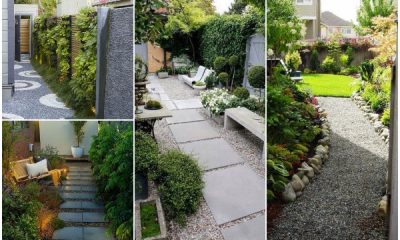
 GARDEN9 tháng ago
GARDEN9 tháng ago30 Shimmering Side Yard Landscape Ideas
-

 ANIMALS10 tháng ago
ANIMALS10 tháng agoKindhearted Driver Rescues Skinny Dog Hiding Near Highway Thanks to His Eagle Eye
-

 FUNNY10 tháng ago
FUNNY10 tháng ago22 Design Fails That Will Make You Laugh Out Loud
-

 DIY & CRAFT10 tháng ago
DIY & CRAFT10 tháng ago19 Easy and Creative DIY Ideas to Enhance Front Yard




